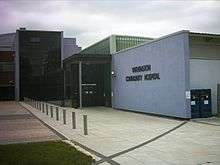Withington Community Hospital
| Withington Community Hospital | |
|---|---|
 The new Withington hospital facilities | |
| Geography | |
| Location | Manchester, England, United Kingdom |
| Organisation | |
| Care system | Public NHS |
| Hospital type | Specialist |
| Affiliated university | University of Manchester |
| Services | |
| Emergency department | No Previously Level 1 Trauma center |
| Speciality | Diagnostics[1] |
| History | |
| Founded | 1854 |
| Links | |
| Website | www.manchester.nhs.uk |
| Lists | Hospitals in England |
Withington Community Hospital (officially known as the Withington Community Hospital and Diagnostic and Treatment Centre) was a hospital in south Manchester, England.
A new hospital building to the south-east of the old site is now a primary care base, run by University Hospital of South Manchester [2] it now provides specialist care to those who are awaiting diagnostic treatment and day surgery appointments.[1]
At its height, the hospital was the largest teaching hospital in Europe,[3] thanks in part to its affiliation with the University of Manchester, which has one of the largest medical schools in the north of England.[4]
History

Originally known as the Chorlton Barlow Moor Work House,[5] the hospital was purpose-built in 1854–55 as a workhouse for the poor of the Chorlton Poor Law Union, which covered most of south Manchester.[6] In 1859 it had as inmates 458 adults (including minors of 17 and upwards) and 195 children. In the 1880s conditions were improved at the instigation of Dr J. Milson Rhodes one of the board members: the removal of the children to Styal was one of his reforms.[7] In 1864-66, it was converted into a hospital for the poor with the notable British nurse, Florence Nightingale, quoted as saying "... your hospital plan will be one of the best, if not the best, in the country" when writing to the architect Thomas Worthington–upon initial observation of the plans.[6] The hospital also provided support for the military just after the outbreak of the First World War in 1914 and German prisoners of war were kept there. At this time it was known as simply Withington Hospital, being named that after a change in 1910. (It was until 1904 outside the city of Manchester in Withington Urban District.)[5] The frontage of 1854–55 is showy and the chapel is Italianate in style: behind were the seven pavilions of the hospital of 1864-66 with many later buildings all over the site.[8] In the later years all the old buildings were taken over by the hospital and a new smaller workhouse was built on the opposite side of Nell Lane: this closed in 1928.[9]
It was occupied by the military for some time before reverting to civilian patients: in 1929 it had beds for 1,300 patients, 12 pavilions and 11 visiting staff.[10] The National Health Service form was introduced in 1948 under Aneurin Bevan. It had developed considerably since that period until the 1990s, when the hospital faced closure; its fate was sealed when the doors shut in 2002. When this occurred, the trust operating the then defunct hospital relocated units across the city.[5][11] Three of the former buildings are Grade II listed.[11]
Re-development
.jpg)
In July 2008, the named developers (PJ Livesey) of the older buildings of the hospital announced that the plans to build 360 homes had been shelved. The structures were to be considered for a full refurbishment into 116 apartments, 231 flats, 14 houses and other structures. It was confirmed this action was a result of the economic downturn affecting potential buyers.[6]
See also
References
- 1 2 "Details pertaining to Withington Hospital". Manchester Primary Care Trust. 2008. Archived from the original on 17 March 2008. Retrieved 18 July 2008.
- ↑ "Health Services in Manchester". manchester.gov.uk. Manchester City Council. NHS Hospital Trusts and other Care Trusts in Manchester. Retrieved 18 July 2008.
- ↑ Camber, Rebecca (4 June 2004). "Homes or a hospital?". Manchester Evening News. M.E.N. Media. Retrieved 18 July 2008.
- ↑ "Manchester unites to target world league". London: Sunday Times. 10 September 2006. Retrieved 18 July 2008.
- 1 2 3 "Discovering Withington Hospital". July 2007. Archived from the original on 23 June 2008. Retrieved 18 July 2008.
- 1 2 3 Wright, Susannah (17 July 2008). "Sick market hits £72m homes plan at hospital". South Manchester Reporter. M.E.N. Media. Retrieved 18 July 2008.
- ↑ France, E.; Woodall, T. F. (1976) A New History of Didsbury. Manchester. E. J. Morten; pp. 81–83
- ↑ Hartwell, Clare, et al. 2004) Lancashire: Manchester and the South-east. New Haven CT: Yale U. P.; p. 486
- ↑ France (1976)
- ↑ The Book of Manchester and Salford; written for the British Medical Association. Manchester: George Falkner & Sons, 1929; pp. 138
- 1 2 "Report 14 - Consideration of forwarded plans" (PDF). Manchester City Council. Retrieved 18 July 2008.
Bibliography
- Sim, R. & Kitchen, H. (1999) More Than a Place of Healing: an anthology of memories, memorabilia and anecdotes of Withington Hospital Manchester Manchester: Hospital Arts
External links
- Withington Community Hospital web page
- Pictures of the derelict buildings
- Manchester district Poor Law records
Coordinates: 53°25′31″N 2°14′45″W / 53.42528°N 2.24583°W